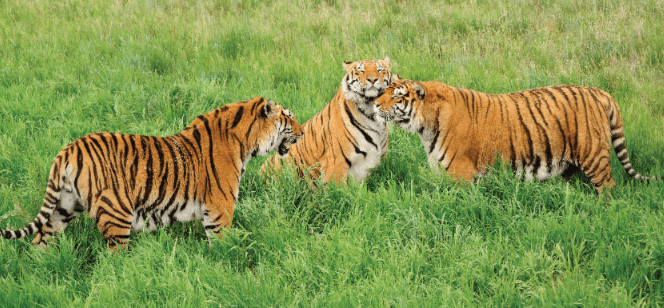An exotic animal sanctuary serves as a refuge for creatures that cannot flourish in the wild or in traditional zoos. An exotic animal sanctuary in Omaha, NE, plays a pivotal role by providing care, shelter, and a safe environment for rescued animals, many of which have been abandoned, neglected, or exploited. However, running a sanctuary is about much more than offering food and medical care.
Sanctuaries must create suitable, well-maintained habitats that address these animals’ specific physical, emotional, and psychological needs to guarantee their fulfilling lives.
The Importance of a Suitable Habitat at an Exotic Animal Sanctuary in Omaha, NE
A proper habitat goes beyond being a physical space. It’s a place where animals can exhibit natural behaviors, feel secure, and remain healthy. Each species has unique needs for space, temperature, shelter, and terrain. Large cats like tigers, for example, require room to roam, while smaller species need densely vegetated areas to feel safe. In Omaha, where temperatures range from freezing winters to hot summers, sanctuaries must guarantee that habitats offer heating, cooling, and shade to keep the animals comfortable.
Besides meeting physical needs, animals need mental stimulation. Without it, they may develop stress-related behaviors like pacing or aggression. Enclosures should encourage discovery, play, and rest by including features like climbing structures, water sources, and toys. Social animals require companionship, while solitary species need spaces where they can retreat. Sanctuaries must consider these factors to create harmonious environments for all animals.
Challenges of Creating and Maintaining Animal Habitats
Developing and maintaining suitable habitats demands extensive planning, resources, and continuous oversight to keep up with the animals’ changing needs.
Financial Resources
Building habitats that mimic natural environments can be expensive. This includes constructing safe enclosures, purchasing enrichment tools, and maintaining the space. Sanctuaries in Omaha face financial challenges, as donations, grants, and fundraising efforts are essential to keep the sanctuary running. These funds must be carefully managed to prioritize habitat upkeep.
Furthermore, with limited budgets, sanctuaries often get creative with enrichment options. For instance, simple and affordable additions like logs, tires, or barrels can provide stimulating activities for the animals. However, larger projects such as building new enclosures or installing advanced climate control systems demand significant funding.
Space Constraints
Moreover, exotic animals need more room than domestic animals, and sanctuaries often struggle to provide enough space, especially for large species like lions, tigers, and bears. Land can be expensive or limited in urban or suburban areas. As a result, sanctuaries in Omaha must balance the need for spacious enclosures with the reality of available land and resources.
Even when space is limited, an exotic animal sanctuary in Omaha, NE, can maximize the area by using multi-level structures, creative landscaping, and vertical space. These techniques help create habitats that feel larger and more stimulating for the animals.
Climate Considerations
In addition to space challenges, Omaha’s climate adds another layer of complexity. The city experiences freezing winters and hot, humid summers, which means animals’ habitats must handle these extremes. Hence, outdoor enclosures may need to include heated shelters for the winter and shaded areas or ponds for cooling off in the summer.
For tropical species that are used to warmer and stable environments, Omaha’s seasonal changes can be particularly difficult. Heating lamps, humidifiers, and specialized enclosures may be required to keep these animals comfortable. Sanctuaries must consistently monitor temperature and humidity to sustain optimal conditions for their animals.
Safety and Security
Safety is a fundamental aspect of habitat design. Large predators and dangerous animals require secure enclosures that prevent escape and protect them from external threats. This involves strong fencing, regular safety checks, and secure gates to protect both the animals and the staff.
However, creating secure habitats should not make the animals feel confined. Thus, a balance must be struck between security and freedom of movement. For example, providing high vantage points, open spaces, and hidden corners allows animals to feel more at ease in their enclosures, giving them opportunities to wander and retreat as needed.
The Role of Enrichment in Animal Habitats
Enrichment is essential for keeping sanctuary animals engaged, healthy, and content. Without proper enrichment, animals can become bored or frustrated, leading to stress and behavioral problems.
Environmental Enrichment
Sanctuaries should incorporate natural elements like rocks, logs, and plants to create environments that feel more genuine. Water features like ponds or streams encourage natural behaviors such as bathing or swimming. Heightened platforms or trees allow climbing animals to discover and engage in their natural instincts.
Physical Enrichment
Providing animals with toys, puzzle feeders, and interactive elements encourages physical exercise and mental stimulation. These features keep the animals active and mentally sharp, helping them maintain a healthy weight and improve their overall health. Sanctuary staff can introduce rotating toys or rearrange structures to continuously challenge the animals and prevent boredom.
Social Enrichment
Interaction with others is an important form of enrichment for social species. Sanctuaries must guarantee that social animals have companions and safe spaces where they can engage without feeling threatened. Group dynamics should be closely monitored to avoid aggression or dominance issues. Meanwhile, solitary animals should have their own space to retreat when needed, as forcing interaction can lead to stress or anxiety.
Sensory Stimulation
Sensory enrichment, such as introducing scents, sounds, or different textures, can stimulate the animals’ senses. This type of enrichment helps mimic the varied stimulation they would experience in the wild, keeping their minds engaged. For example, unfamiliar scents or objects from nature can prompt exploratory behavior, while recorded sounds of other animals or environments can create a more stimulating setting.
Conclusion
In conclusion, the success of an exotic animal sanctuary in Omaha, NE, depends on creating habitats that meet the animals’ physical, emotional, and social needs. By supporting these sanctuaries through donations or volunteer work, we can help guarantee that exotic animals continue to have the safe and nurturing environments they need to flourish.
Visit JS Exotics today to learn how you can actively support exotic animal care and conservation efforts.

